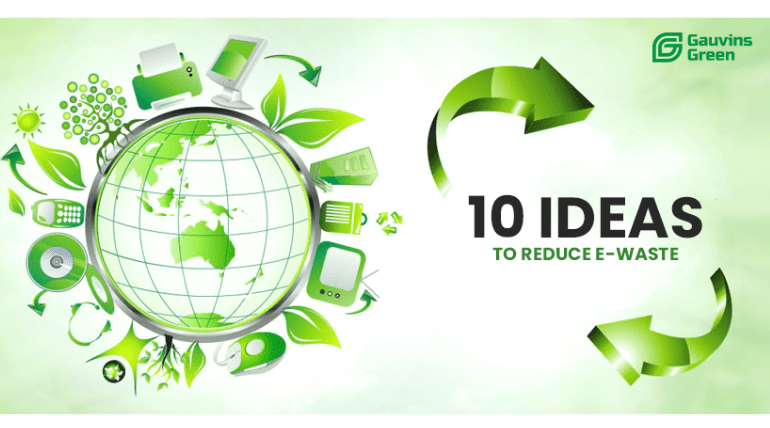Ideas to Reduce e-waste
E-waste, or electronic waste, is a growing environmental problem as technology becomes increasingly pervasive in our lives. From smartphones to laptops to televisions, electronic devices are being discarded at an alarming rate, posing a significant threat to both human health and the environment. Therefore it is crucial to develop effective e-waste disposal methods to minimize this threat. We’ll study in this blog the ten innovative ideas that can lessen e-waste and enhance e-waste disposal methods.
Upgradeable Designs: A Game-Changing Approach to Reducing E-Waste
Design products that are modular and upgradeable, so that consumers can replace individual components rather than discarding the entire device when one part becomes obsolete. This approach can help reduce e-waste by extending the useful life of products. By designing products that are easy to upgrade, manufacturers can minimize the amount of electronic waste that ends up in landfills. This, in turn, can reduce the need for e-waste management services.
The Power of Product Take-Back Programs to Encourage Responsive E-Waste Disposal
Implement a product take-back program that allows consumers to return old electronics for proper disposal or recycling. This can be a powerful solution to e-waste. Manufacturers and merchants can collaborate to design a scheme that rewards customers for returning their used devices. For instance, businesses may provide free e-waste recycling services or discounts on new devices. Companies may lower their e-waste production and enhance their e-waste management services by introducing a product take-back programme.
Eco-Friendly Technologies: Sustainable Solutions to the E-Waste Crisis
Develop new technologies that are more environmentally friendly and sustainable, such as biodegradable or easily recyclable materials. In order to reduce e-waste, researchers are always looking into novel materials and production techniques. Businesses may lower the quantity of electronic trash that ends up in landfills by creating goods with less environmentally damaging ingredients. This can improve e-waste recycling efforts and reduce the need for e-waste management services.
Less is More: How Non-Toxic Materials Can Help Reduce E-Waste
It’s critical that businesses utilize less hazardous materials in their electronics. The environment and humans should not be exposed to substances like le by doing this.
Recycling Incentives: Making the Right Decision Simple
You may encourage individuals to recycle their old equipment by giving them discounts on new purchases or tax credits. This may persuade individuals to recycle their outdated devices as opposed to throwing them away. Companies may reduce their e-waste production and enhance their e-waste management services by providing incentives for recycling.
Government Regulations: A Crucial Tool for Proper E-Waste Management
The government must also develop regulations for the disposal of electronic trash. This will guarantee that e-waste is securely and effectively managed. Recycling obsolete equipment can be made easier with the support of government legislation on the subject. This is important since it may reduce the amount of electronic waste disposed of in landfills. By doing this, the government can make sure that e-waste is appropriately treated and does not harm the environment.
Sharing is Caring: How the Sharing Economy Can Aid in Waste Reduction
Encourage people to share their technology so that people may rent or borrow it rather than purchase it outright. This is an innovative e-waste solution. People may lessen the quantity of e-waste produced by sharing their electronic equipment. Additionally, it can increase efforts to recycle e-waste and lessen the burden on e-waste management services.
Spreading the Word: Public Awareness Campaigns and the Fight Against E-Waste
Increase the number of public awareness programs highlighting the need to reduce e-waste and its negative effects on the environment. Increasing public awareness of e-waste can significantly reduce its production. Companies may inspire individuals to take action to decrease e-waste by increasing awareness about the issues and the solutions that are available. E-waste management services and e-waste recycling initiatives may benefit from this.
Beyond Planned Obsolescence: How Business Models Can Encourage Sustainable Products
Businesses may encourage the creation of sustainable products by offering lifetime guarantees and reasonably priced repair services, which will help to cut down on e-waste. This would encourage companies to design products that last longer and are easier to repair, ultimately improving e-waste disposal methods.
Rethinking Recycling: Innovative Approaches to Repurposing E-Waste
Urban mining can extract valuable materials from e-waste and reduce the need for new mining, while upcycling can transform e-waste into new and valuable products. By rethinking e-waste recycling and exploring innovative approaches to repurposing e-waste, we can reduce the amount of electronic waste that is generated and improve e-waste disposal methods.
Conclusion
In conclusion, reducing e-waste is a crucial goal for both individuals and businesses. By implementing these 10 innovative ideas, we can improve e-waste disposal methods and help reduce the negative impact of electronic waste on the environment. There are various ways we can cooperate to lower the quantity of electronic trash produced and enhance e-waste disposal methods, from eco-friendly technology to encouraging sustainable product design and investigating novel alternatives to repurpose e-waste. We can build a better future for the earth and for ourselves by making sustainable decisions.


